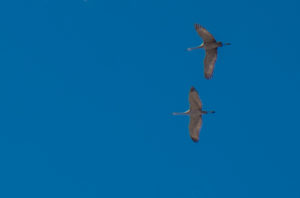Reconciliation ecology, the field’s founders say, “says we still have time to save most of the world’s species. But to do it, we must stop trying to put an end to civilization and human enterprise. Instead, we need to work on the overwhelming bulk of the land — the places we humans use. We need to make them over so that they can support both us and other species.”

sandhill cranes, Bernardo, NM
Sena Christian has a great piece in the most recent Comstock Magazine that leads us through one of the most interesting reconciliation ecology experiments currently underway in the irrigated landscapes of the American West, a collaboration among farmers and environmentalists on the rice fields of Northern California:
Farmers typically drain the water in late January so the soil has time to harden for the upcoming season. Could they be encouraged to keep their fields flooded a few inches into February and March, to provide surrogate wetlands for birds traveling north along the Pacific Flyway? The Nature Conservancy posed this question when piloting its Bird Returns program in 2014.
Bird Returns essentially rents fields from farmers on a short-term basis, using a reverse auction: Farmers place a bid for what they want to be paid per acre to keep their fields flooded. Sellers with the most reasonable bids and conducive fields are enrolled.
This is a piece of what I’m planning on talking about in a talk next week at UNM’s “Decolonizing Nature” conference in Albuquerque. The premise is that we’re not going to return our rivers to their state before the time-of-lots-of-humans (TOLOH). The large forces unleashed by TOLOH – the influence, for example, of the global price of rice on California’s landscape – are here to stay. How do we move beyond a traditional return-to-nature style of environmentalism to a nature-among-us?
